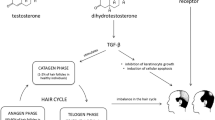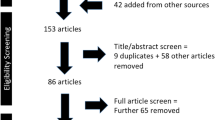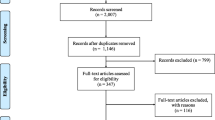Abstract
Purpose
Patients’ perspective of their treatment regime plays a vital role in its success. Recognizing the high prevalence of medicinal plant usage among Jamaicans at large, we investigated the engagement of such remedies by cancer patients, with the aim of uncovering self-medicating habits, perceptions and details of utilized plants.
Methods
A structured, interviewer-based questionnaire was administered to 100 patients attending the oncology and urology clinics at the University Hospital of the West Indies in Kingston, Jamaica. A method of convenience sampling was employed and the data were analyzed using summary statistics and statistical significance tests.
Results
A large proportion (n = 80, 80%) of interviewed patients, engaged medicinal plants in their treatment regimes. Such habits were independent of person’s education, economic status and were higher among the 55–74 age groups (p < 0.05) compared with younger patients. The use of herbs was hinged on the patient’s strong sense of tradition and positive perspective of herbal efficacy (88%), fueled by anecdotal accounts from fellow patients. Majority of such users (74.7%) were under concomitant treatment with a prescription medicine, and worryingly, only 15% of patients made their oncologists aware. Annona muricata L. and Petiveria alliacea L. were the most commonly used plants for treating breast and prostate cancers, respectively.
Conclusion
A large proportion of Jamaican cancer patients use medicinal plants in self-medicating practices and their perceptions and habits need to be considered by physicians, in the design of safe and effective care regimes.

Similar content being viewed by others
References
Gibson TN, Hanchard B, Waugh N, McNaughton D (2010) Age-specific incidence of cancer in Kingston and St. Andrew, Jamaica, 2003–2007. West Indian Med J 59(5):456–464
Morrison B, Aiken W, Mayhew R (2014) Current state of prostate cancer treatment in Jamaica. ecancer. doi:10.3332/ecancer.2014.456
Pinheiro PS, Callahan KE, Ragin C, Hage RW, Hylton T, Kobetz EN (2016) Black heterogeneity in cancer mortality: US-Blacks, Haitians, and Jamaicans. Cancer Control J Moffitt Cancer Center 23(4):347–358
Coronado Interis E, Anakwenze CP, Aung M, Jolly PE (2015) Increasing cervical cancer awareness and screening in Jamaica: effectiveness of a theory-based educational intervention. Int J Environ Res Public Health. doi:10.3390/ijerph13010053
Delgoda R, Younger N, Barrett C, Braithwaite J, Davis D (2010) The prevalence of herbs use in conjunction with conventional medicines in Jamaica. Complement Ther Med 18(1):13–20
Falci L, Shi Z, Greenlee H (2016) Multiple chronic conditions and use of complementary and alternative medicine among US adults: results from the 2012 national health interview survey. Prev Chronic Dis 13:E61
Picking D, Younger N, Mitchell S, Delgoda R (2011) The prevalence of herbal medicine home use and concomitant use with pharmaceutical medicines in Jamaica. J Ethnopharmacol 137(1):305–311
Delgoda R, Ellington C, Barrett S, Gordon N, Clarke N, Younger N (2004) The practice of polypharmacy involving herbal and prescription medicines in the treatment of diabetes mellitus, hypertension and gastrointestinal disorders in Jamaica. West Indian Med J 53(6):400–405
Picking D, Delgoda R, Younger N, Germosen-Robineau L, Boulogne I, Mitchell S (2015) TRAMIL ethnomedicinal survey in Jamaica. J Ethnopharmacol 169:314–327
Kitchenham B, Pfleeger SL (2002) Principles of survey research: part 5: populations and samples. ACM SIGSOFT Softw Eng Notes 27(5):17–20
WHO (2002) WHO launches the first global strategy on traditional and alternative medicine. World Health Organization. www.who.int/mediacentre/releases/release38/en/
Poonthananiwatkul B, Howard RL, Williamson EM, Lim RH (2015) Cancer patients taking herbal medicines: a review of clinical purposes, associated factors, and perceptions of benefit or harm. J Ethnopharmacol 175:58–66
Clement Y, Mahase V, Jagroop A, Kissoon K, Maharaj A, Mathura P, Quan C, Ramadhin D, Mohammed C (2016) Herbal remedies and functional foods used by cancer patients attending speciality oncology clinics in Trinidad. BMC Complement Altern Med. doi:10.1186/s12906-016-1380-x
World Bank (2015) World Bank national accounts data, and OECD National Accounts data files
Delgoda R, Westlake AC (2004) Herbal interactions involving cytochrome p450 enzymes: a mini review. Toxicol Rev 23(4):239–249
Alsanad SM, Howard RL, Williamson EM (2016) An assessment of the impact of herb–drug combinations used by cancer patients. BMC Complement Altern Med 16(1):393
Fakeye TO, Tijani A, Adebisi O (2007) A survey of the use of herbs among patients attending secondary-level health care facilities in southwestern Nigeria. J Herb Pharmacother 7(3–4):213–227
Olisa NS, Oyelola FT (2009) Evaluation of use of herbal medicines among ambulatory hypertensive patients attending a secondary health care facility in Nigeria. Int J Pharm Pract 17(2):101–105
Stub T, Quandt SA, Arcury TA, Sandberg JC, Kristoffersen AE, Musial F, Salamonsen A (2016) Perception of risk and communication among conventional and complementary health care providers involving cancer patients’ use of complementary therapies: a literature review. BMC Complement Altern Med 16:353
Singh S, Sharma B, Kanwar SS, Kumar A (2016) Lead phytochemicals for anticancer drug development. Front Plant Sci 7:1667
Francis S, Laurieri N, Nwokocha C, Delgoda R (2016) Treatment of rats with apocynin has considerable inhibitory effects on arylamine N-Acetyltransferase activity in the liver. Sci Rep 6:26906
Badal S, Brantley E, Delgoda R et al (2017) Glaucarubulone glucoside from Castela macrophylla suppresses MCF-7 breast cancer cell growth and attenuates benzo[a]pyrene-mediated CYP1A gene induction. J Appl Toxicol. doi:10.1002/jat.3436
Shields M, Niazi U, Badal S, Yee T, Sutcliffe MJ, Delgoda R (2009) Inhibition of CYP1A1 by quassinoids found in Picrasma excelsa. Planta Med 75(2):137–141
Wani MC, Horwitz SB (2014) Nature as a remarkable chemist: a personal story of the discovery and development of Taxol. Anticancer Drugs 25(5):482–487
WHO (2008) Beijing declaration. http://www.who.int/medicines/areas/traditional/TRM_BeijingDeclarationEN.pdf?ua=1. Accessed 11 July 2017
Clement Y (2011) Limited clinical evidence to support the integration of Caribbean herbs into conventional medicine. Focus Altern Complement Ther 16(4):289–292
Liu N, Yang HL, Wang P, Lu YC, Yang YJ, Wang L, Lee SC (2016) Functional proteomic analysis revels that the ethanol extract of Annona muricata L. induces liver cancer cell apoptosis through endoplasmic reticulum stress pathway. J Ethnopharmacol 189:210–217
Williams L, Rosner H, Levy H, Barton E (2007) A critical review of the therapeutic potential of dibenzyl trisulphide isolated from Petiveria alliacea L. (guinea hen weed, anamu). West Indian Med J 56(1):17–21
Luz D, Pinheiro A, da Silva M, Monteiro MC, Prediger RD, Maia CSF, Fontes-Junior EA (2016) Ethnobotany, phytochemistry and neuropharmacological effects of Petiveria alliacea L. (Phytolaccaceae): a review. J Ethnopharmacol. doi:10.1016/j.jep.2016.02.053
Murray J, Picking D, Lamm A, McKenzie J, Hartley S, Watson C, Williams L, Lowe H, Delgoda R (2016) Significant inhibitory impact of dibenzyl trisulfide and extracts of Petiveria alliacea on the activities of major drug-metabolizing enzymes in vitro: an assessment of the potential for medicinal plant–drug interactions. Fitoterapia 111:138–146
Acknowledgments
The authors are grateful to Nursing Staff at the Oncology and Urology Clinics at the UHWI, for their assistance during patient recruitment. They also gratefully acknowledge funding support from the National Health Fund, Jamaica and supervisory support from Professor Helen Asemota.
Author information
Authors and Affiliations
Corresponding author
Ethics declarations
Conflict of interest
The authors declare that they have no conflict of interest.
Ethical approval
All procedures performed in studies involving human participants were in accordance with the Ethical Standards of the Institutional and/or National Research Committee and with the 1964 Helsinki Declaration and its later amendments or comparable ethical standards.
Informed consent
Informed consent was obtained from all individual participants included in the study.
Electronic supplementary material
Below is the link to the electronic supplementary material.
Rights and permissions
About this article
Cite this article
Foster, K., Younger, N., Aiken, W. et al. Reliance on medicinal plant therapy among cancer patients in Jamaica. Cancer Causes Control 28, 1349–1356 (2017). https://doi.org/10.1007/s10552-017-0924-9
Received:
Accepted:
Published:
Issue Date:
DOI: https://doi.org/10.1007/s10552-017-0924-9




